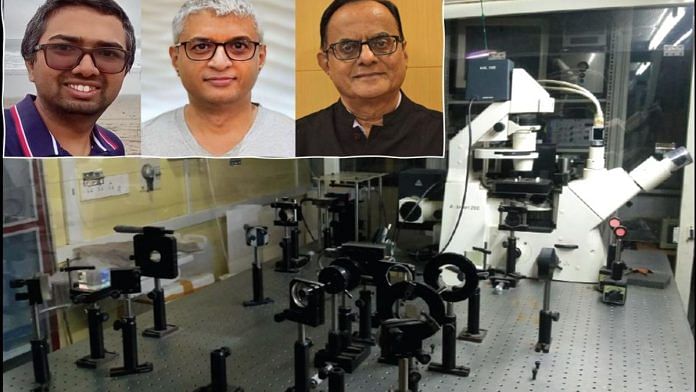Bengaluru: Scientists in Bengaluru have done the impossible. They’ve made an engine that suffers almost no heat loss. It’s a tiny microscopic heat engine, but overcomes a major problem in thermodynamics — producing maximum power at maximum efficiency.
Achieving high efficiency with high power has long been considered almost impossible as conversion of heat to energy causes heat loss in the process.
That hurdle has now been solved by a team of scientists from the Bengaluru-based Indian Institute of Science (IISc) and Jawaharlal Nehru Centre For Advanced Scientific Research (JNCASR), potentially paving the way for extremely energy-efficient devices in the future, such as mobile phones that don’t heat up during use.
The paper detailing the findings was published this week in the journal Nature Communications.
The contraption designed on a micro scale uses a laser beam instead of gas for fuel, and functions like a piston, operating with just a single particle.
Upon applying varying electric fields to this micro engine, scientists were able to drastically lower heat loss, leading to an efficiency of nearly 95 percent.
“What was considered impossible until today, we have demonstrated that it is possible: achieving both high efficiency and high power simultaneously,” said Ajay K. Sood, Principal Scientific Adviser to the Government of India who is also National Science Chair Professor in IISc’s department of physics, and the study supervisor and one of its authors.
The “engine” is made up of a colloidal bead, or a single particle floating in a solution, and a laser beam is used to direct its motion, similar to a piston in regular engines. The electric field is then applied to this setup.
This design is called a ‘Stirling’ engine, where air or gas is compressed and expanded between various temperature ranges periodically, resulting in heat energy being converted to mechanical work.
Previously, the team had used a single bacterium to push the particle in it, and power the engine, instead of an electric field, but this proved much less efficient.
The findings show that under specific conditions, high power can indeed be achieved along with high efficiency.
Also Read: Did you know there’s a giant ‘gravity hole’ in Indian Ocean? IISc scientists may have found out why
Bane of engine design
In the study, the authors describe the inability to maximise both efficiency and power in machines of various scales as the “bane of energy design” for two centuries.
Optimal designs for all engines either produce high energy with low efficiency, or low energy with high efficiency.
This is the power-efficiency trade-off.
Many theoretical studies have assessed the problem, concluding that the trade-off is universal in all kinds of engines of various scales.
For a system or an engine to be 100 percent efficient, when any process is reversed, the original state has to be restored with no wasted heat. But this has eluded scientists in real-life experiments.
It is only theoretically possible if the process is so slow that there is no energy loss; but this results in power output also being zero, making the engine useless.
This is considered to be in line with the second law of thermodynamics, which states that the entropy (measure of a system’s thermal energy per unit temperature that is unavailable for doing useful work) cannot decrease in an isolated system by itself and natural processes moving forward in time cannot be reversed. This is also referred to as the concept of arrow of time, which moves in only one direction.
The law has been experimentally observed and proved in many ways, including by famous French scientist Sadi Carnot in 1824. He demonstrated that the efficiency of conversion of heat to power/work in a heat engine had a maximum upper limit, and could never be 100 percent.
Simply put, Carnot’s theorem states that when heat moves from a hot to cold body, there is heat loss; and heat cannot flow from a colder to a warmer body.
This theorem has been deemed fundamental and has been immutable for over 200 years, until now.
‘Thermodynamic puzzle’
Overcoming the trade-off between power and efficiency in heat engines depends on the mechanism of heat transfer, explain the scientists in their paper.
“Since the 1970s, people have been attempting to address the power-efficiency trade-off. In the early 2000s, researchers explored microscopic systems to overcome this challenge. Interestingly, in 2017, a paper claimed that it was impossible to solve this thermodynamic puzzle,” said Sudeesh Krishnamurthy, former PhD student at the IISc Department of Physics and first author of the paper, in a statement.
The IISc-JNCASR team continued working in microscopic systems.
They simulated the processes of a conventional heat engine at a scale observable only under the microscope, in an engine that is the size of 1/100th the width of a single human hair, said Professor Rajesh Ganapathy of JNCASR, among the paper’s authors, in the statement.
“Our unique micro-scale engine operates with just one particle,” he added.
A rapidly varying electric field was applied to this micro-engine to switch it between two states, resulting in nearly 95 percent of the efficiency limit proposed by Carnot, which is the absolute maximum theoretical efficiency for any heat engine.
As a result of the applied electric field, there was a drastic reduction in heat-distribution time, allowing the engine to operate at high efficiency while also producing a large power output, even when functioning at high speeds.
While this engine is still at a micro scale, the next step is to build it to make it scalable and useful practically.
“We have opened doors that scientists almost gave up opening due to the thermodynamic constraints set by Carnot in previous studies,” said Sood.
(Edited by Sunanda Ranjan)
Also Read: IISc, India’s lone science gem that keeps topping global rankings, leaving IITs, IIMs behind



